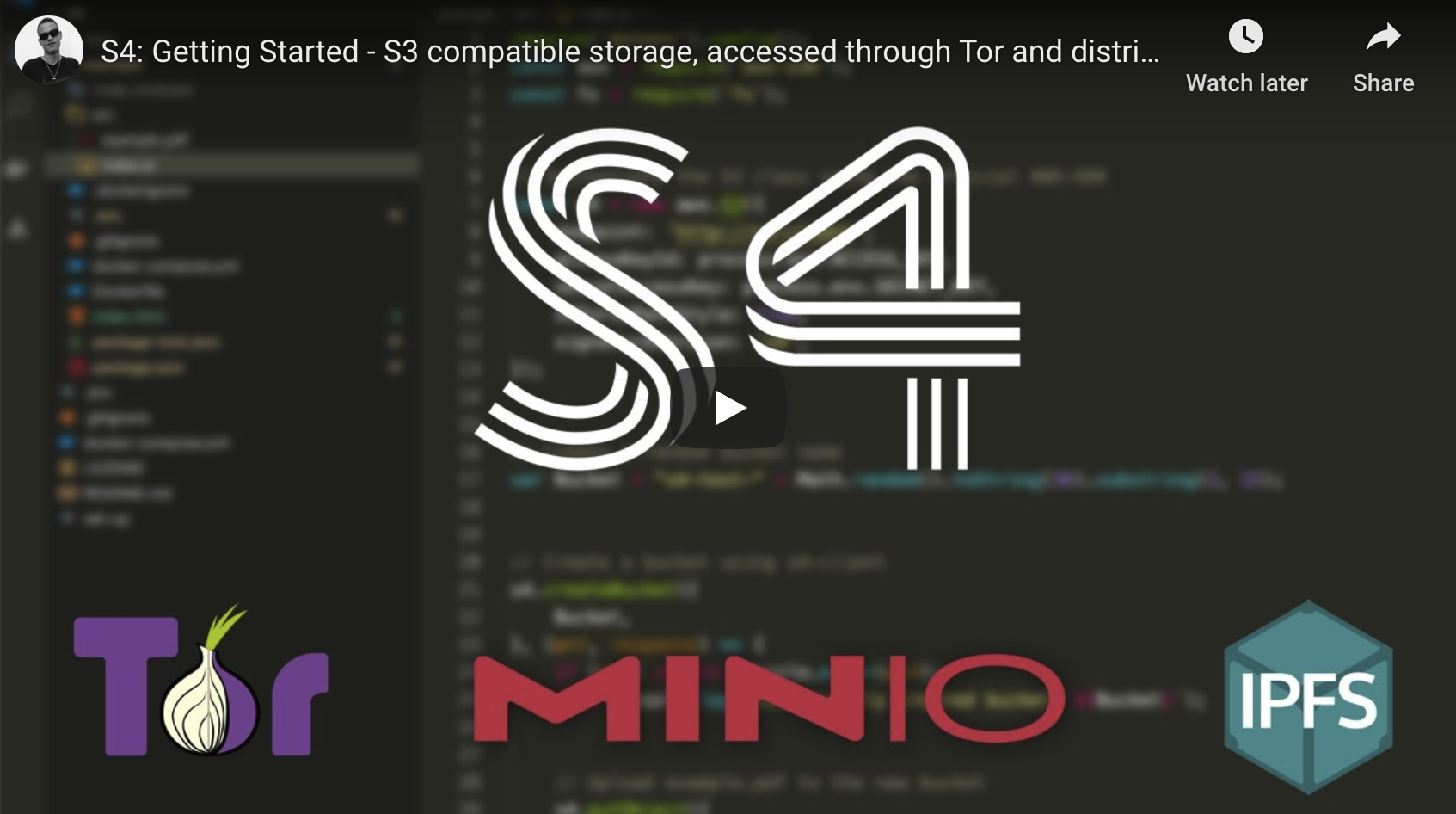https://github.com/anthonybudd/s4
S4 is 100% S3 compatible storage, accessed through Tor and distributed using IPFS.
https://github.com/anthonybudd/s4
data docker ipfs object-storage s3 s4 storage
Last synced: 17 days ago
JSON representation
S4 is 100% S3 compatible storage, accessed through Tor and distributed using IPFS.
- Host: GitHub
- URL: https://github.com/anthonybudd/s4
- Owner: anthonybudd
- License: mit
- Created: 2020-10-05T11:57:42.000Z (over 4 years ago)
- Default Branch: master
- Last Pushed: 2021-03-03T20:08:07.000Z (about 4 years ago)
- Last Synced: 2024-02-14T21:56:22.917Z (about 1 year ago)
- Topics: data, docker, ipfs, object-storage, s3, s4, storage
- Language: Shell
- Homepage:
- Size: 2.07 MB
- Stars: 93
- Watchers: 2
- Forks: 9
- Open Issues: 2
-
Metadata Files:
- Readme: README.md
- License: LICENSE
Awesome Lists containing this project
README

# S4
S4 is 100% compatible AWS S3 storage, accessed through Tor and distributed using IPFS.
Tor acts as a DNS and *hides* the physical location of the S4 server. [IPFS](https://github.com/ipfs/ipfs) acts as a CDN and will make your data permanently accessible and is impossible to take offline once it has been published. A [sidecar docker container](https://github.com/anthonybudd/s4-client) is provided to seamlessly proxy requests from your existing S3 code over Tor to S4.
## Create S4 server
You can set-up your own local S4 server with just 4 commands.
```sh
$ git clone [email protected]:anthonybudd/S4.git && cd S4/
$ cp .env.example .env
$ docker run -it --rm -v $(pwd)/data/tor:/web anthonybudd/s4-tor-proxy generate ^s4
$ docker-compose up
```
## Node.js AWS-SDK Example
Once you have created your local S4 server, you can test it using the included [example](https://github.com/anthonybudd/S4/blob/master/example/src/index.js). This demo shows the current Node.js AWS-SDK working with the [sidecar docker container](https://github.com/anthonybudd/s4-client) to proxy the AWS S3 requests over Tor back to your local S4 server.
```sh
$ cd example/
$ nano .env
$ docker-compose up -d
$ docker exec -ti my-app node src/index.js
```
## Architecture

Tor does not just provide anonymity, Tor acts as a DNS. S4 uses Tor hidden services, data is uploaded into an S4 bucket over Tor. This also means you can create a free .onion domain name without needing any 3rd-parties. A [sidecar container](https://github.com/anthonybudd/s4-client) is provided to seamlessly proxy requests from your existing S3 code over Tor to S4.
IPFS acts as a CDN. Each S4 bucket is published to IPFS under a separate key allowing you to address your files using any existing IPFS HTTP gateway like this [https://ipfs.io/ipns/[BUCKET-KEY]/image.jpg](http://ipfs.io/ipns/QmTvcZ719MEiYjhn2RxwtiYGkJr6ea4xnSGqdxj5vRii8k/flag.jpg). This link will never change or go offline, the more people who request it, the faster the data will be returned to the user.
## Build a Node

S4 is designed to democratise object-storage technology so anyone can have S3-like data storage without needing to depend on giant cloud tech providers. It was specifically built to run on a Raspberry Pi in production. A full blog post has been provided with in-depth instructions on how to build your own S4 node. A basic overview is provided below.
- Install Ubuntu 20.04
- `$ git clone [email protected]:anthonybudd/S4.git`
- `$ cd S4`
- `$ ./install`
- `$ sudo mount /dev/XXX /mnt/ssd`
- `$ sed -i "" "s#S4_ROOT=.*#S4_ROOT=/mnt/ssd#" .env`
- `$ sed -i "" "s#ACCESS_KEY=.*#ACCESS_KEY=$(openssl rand -hex 10)#" .env`
- `$ sed -i "" "s#SECRET_KEY=.*#SECRET_KEY=$(openssl rand -hex 20)#" .env`
- `$ sudo reboot`
- `$ docker run -it --rm -v /mnt/ssd/tor:/web anthonybudd/s4-tor-proxy:arm64v8 generate ^s4`
- `$ docker-compose up`
